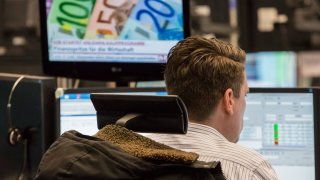
- The prospect of an economic slowdown also casts a specter of doubt over whether the European Central Bank will be able to tighten monetary policy sufficiently to rein in record-high inflation.
- Deutsche Bank suggested that the euro could fall into the $0.95-0.97 range if "Europe and the U.S. find themselves slip-sliding in to a (deeper) recession in Q3 while the Fed is still hiking rates."
The euro dropped below $1.02 this week, continuing its slide to new 20-year lows and potential parity with the U.S. dollar.
The euro traded as low as $1.0165 on Wednesday afternoon in Europe, before recovering slightly to hover just above the $1.02 mark Thursday morning.
The common currency of the euro zone has been in consistent decline as fears of a recession there intensify on the back of rising uncertainty about energy supply to the bloc, with Russia threatening to further reduce gas supplies to Germany and the broader continent.
Get San Diego local news, weather forecasts, sports and lifestyle stories to your inbox. Sign up for NBC San Diego newsletters.
The prospect of an economic slowdown also casts a specter of doubt over whether the European Central Bank will be able to tighten monetary policy sufficiently to rein in record-high inflation.
Deutsche Bank pointed out in a note Wednesday that the stress points extend beyond the German natural gas shortage to the wider European energy market, as evidenced by France's EDF announcing further electricity cutbacks on Wednesday morning.
Deutsche Global Head of FX Research George Saravelos suggested that "safe-haven" moves towards the U.S. dollar could become "even more extreme" as the U.S. enters a technical recession, furthering the downward pressure on the EURUSD trade.
Money Report
"We conclude that a move down to 0.95-0.97 in EUR/USD would match the all-time extremes seen in exchange rates and USD risk premium since the end of Bretton Woods," Saravelos said.
"If both Europe and the U.S. find themselves slip-sliding in to a (deeper) recession in Q3 while the Fed is still hiking rates, these levels could well be reached."
One key catalyst that could reverse the strengthening of the U.S. dollar, he suggested, is a signal that the Fed is entering a protracted pause in its monetary tightening cycle, facilitating a release of some of the risk premium baked into the greenback.
The DXY U.S. dollar index is up more than 11% year-to-date, last trading just below the 107 mark.
Meanwhile, a "clear peak" in European energy tensions via an end to hostilities in Ukraine may offer a path higher for the euro.
"Continued (partial) supply of Russia gas through the summer would in our view not be enough as the risks of a shutdown would persist in to winter," Saravelos added.
The darkening outlook for the European economy comes as the ECB has announced its intention to hike interest rates for the first time since 2011, with euro zone inflation running at a record high 8.6%.
Central banks around the world face a quandary as they attempt to rein in inflation without deepening economic slowdowns, which the data suggest are drawing ever closer.
The Fed is already well out of the blocks on tightening, having hiked its benchmark rate by 75 basis points in June while significantly cutting its 2022 growth outlook.
Minutes from the latest Federal Open Market Committee meeting showed policymakers are worried that the central bank will lose credibility if inflation were to worsen.
In a research note Tuesday, Capital Economics Markets Economist Franziska Palmas said investors across asset classes were discounting a rather adverse economic outcome in the euro zone.
"While we think it would take a significant further deterioration in the outlook for the euro-zone economy for the underperformance of the euro and euro-zone assets to continue, we still expect them to struggle further," she said.
"For one, we think gas supply in the euro-zone will remain tight and gas prices high. This is part of the reason why we expect the euro-zone economy to flirt with recession this year, even though we are only assuming a slowdown, rather than a halt to Russian gas supplies."
Palmas added that the backdrop of aggressive interest rate hikes by central banks and disappointing global economic growth will keep the downward pressure on risky assets and trigger further investor flight towards the traditional "safe haven" U.S. dollar.
"The upshot is that while we don't expect euro-zone assets to continue underperforming their DM peers, we expect their absolute performance to remain poor this year and next," she said.
Germany on Monday recorded its first trade deficit in goods since 1991 as the rise in energy prices sent import costs skywards for Europe's largest economy, while global trade disruption also stifled exports.
The figures were among a host of data releases in recent days that have highlighted the increasingly challenging economic conditions for the euro zone. The July Sentix Economic Index on Monday showed investor morale across the 19-country euro zone has plunged to its lowest level since May 2020, which it said pointed toward an "inevitable" recession.
"Given the nature of Germany's exports which are commodity-price sensitive, it remains hard to imagine that the trade balance could improve significantly from here in the next few months given the expected slowdown in the Eurozone economy," Saxo Bank foreign exchange strategists said in a note last week.
"Meanwhile, high energy prices will still continue to take a toll on the trade balance as well, and possibly dampen the sentiment on EUR. EURUSD is likely to find it tough to go above 1.0500 in a sustained manner, and focus is therefore on the 1.0350 support."






